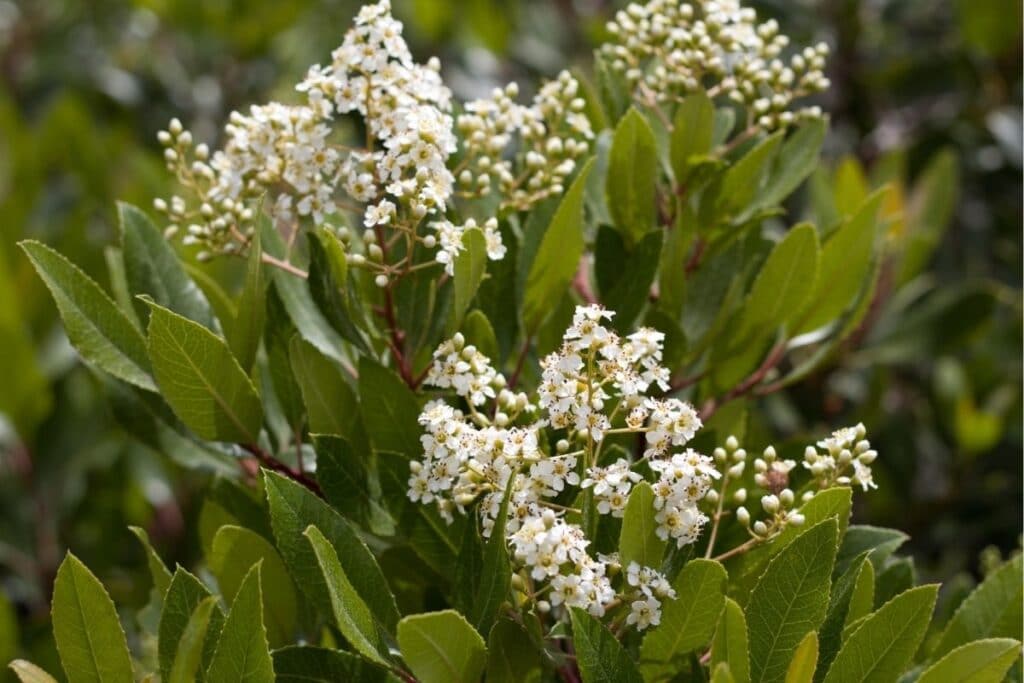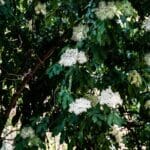Toyon is a beautiful native evergreen bush or small tree from the west coast of the United States. These plants are ideal for gardens on the west coast and will impress with showy displays of creamy white flowers and bright red fruits that persist deep into the early winter months.
What Is A Toyon Plant?
Toyon is a member of the Rose family (Rosaceae) and the only member of the genus Heteromeles. This plant, which is closely related to the Photinias, is also commonly known as the Christmas berry, California holly, or hollywood.
Toyon is an evergreen shrub or tree with multiple gray-brown stems. The mature size of toyon normally reaches 8-12 ft tall by 4-6 ft wide, which makes toyon most suited for large gardens. In some situations, it may reach as large as 15-20 ft. tall.
These plants are native to the west coast of North America, being widespread in California and Baja California. It is most widespread in the Coastal Sage Scrub and Chaparral plant groups in California, although it also thrives in Oak Woodlands and on sandy beach regions distant from the immediate coast. (1)
The dense foliage is made up of dark green leathery leaves with serrated edges. These leaves are glossy and dark green in color, with a leathery texture, and are about 2 inches (5 cm) long and ¾ inch (2 cm) wide.
This Heteromeles arbutifolia evolved in a planting area characterized by winter rains and summer droughts.
Toyon Flowers
Toyon flowers are white or cream white and measure about ¼ inch (6 mm) across. Each flower has 5 rounded petals, and they have a gentle, hawthorn-like aroma that attracts butterflies and other insects. Blossoms occur in abundant flat-topped clusters from late spring to early summer.
After blooming, these small white flowers mature into orange to red fruits which are ¼ to ⅓ inch (6 to 8 mm) across and ripen from October to January. (2)
How To Grow Toyon Tree
Toyon plants can be grown from seeds and will take 10 to 40 days to germinate. (2) If you’d like to harvest your own seeds, soak them in water for about a week after removing them from the ripe fruits. Fall is the ideal season to plant these seeds. (3)
Toyon shrub can be successfully grown from cuttings as well. To do this, take 4 to 5 inches (10 to 12.5 cm) semi-hardwood tip cuttings and remove the lower leaves. Dip your cuttings in a root hormone powder and plant them in a sandy medium. These cuttings will take 2 to 3 months to take root.
These plants do best when planted in well drained soils, although they are adaptable and can be grown in a variety of soil types and pHs.
The Christmas berry is naturally adapted to grow in a winter rainfall region and is usually quite a drought-tolerant. In the summer, mature plants require little to no water, if any at all.
Although these plants are adapted for growth in part shade and dappled sunlight, full sun in zones 9 and 10 will encourage better flowering.
Toyon is a fast-growing plant in the right conditions and can reach 10 feet (3 m) after just three years.
Care and Maintenance
Toyon plants are easy to grow and are very tolerant of pruning. It is best to prune these plants from late winter to early spring, and pruning the branch tips will promote a denser growth shape.
This evergreen shrub can also be trained as a tree by carefully pruning the lower branches, but will generally be multistemmed.
Unfortunately, toyon bush is susceptible to a condition known as fireblight which often affects members of the Rosaceae family. There is a cultivar known as ‘Davis Gold’ which has improved disease resistance. This cultivar has yellow to orange fruits.
Fire blight is a bacterial infection caused by a bacterium known as Erwinia amylovora. The symptoms of this disease are dead and dying branches that turn rust-colored and die from the tip inwards.
This disease can be managed with antibiotic fungicides and infected branches should be cut off at least 8 inches (20 cm) below the damaged area. Take care to disinfect your shears after each cut to avoid spreading the bacteria. (4)
Uses
Horticultural Uses
Toyon is a versatile plant that does great as a hedge, screen, or background planting while being attractive and showy enough to be grown as a specimen. These plants can be kept to a manageable size by regular pruning.
Growing toyon tree in a container is not recommended due to the size these plants can reach. If grown in a suitable location with enough space, toyon can be allowed to grow into a handsome small tree.
With its deep roots and drought tolerance, toyon is also useful for erosion control and slope stabilization.
Human Uses
The fruits of this plant were traditionally eaten by Native Americans but had to be harvested when perfectly ripe. These fruits were usually lightly cooked but also sometimes eaten raw. The green leaves and bark were also used to treat aches and pains. (3)
Wildlife Uses
Toyon is an important wildlife plant. Birds including mockingbirds, American robins, cedar waxwings, coyotes, and bears eat the toyon berries and disperse the seeds, while deer feed on the leaves of this plant. Toyon is a good source of honey and is visited by many pollinators, including butterflies.
FAQs
Can we eat Toyon?
While Toyon (Heteromeles arbutifolia) is not commonly eaten, its berries are technically edible. However, they are considered astringent and somewhat tasteless, and consuming large quantities may cause stomach upset. It’s advisable to exercise caution and consider the potential astringency before consuming them.
What is the common name for Toyon?
The common name for Toyon is “Christmas Berry” or “California Holly.” It earned the nickname “Christmas Berry” because of the bright red berries that adorn the plant during the holiday season.
Is Toyon invasive in California?
Toyon is not considered invasive in California. It is a native plant and an important part of the local ecosystem, providing habitat and food for wildlife. It is not known to cause ecological issues like those associated with invasive species.
Conclusion
Toyon is a great choice for native wildlife gardens, and its easy toyon care makes it versatile enough for planting in many different settings. These beautiful evergreens provide multi-season interest and are generally hardy, thriving with minimal attention.
If you’re looking for a dense shrub or small tree for your Californian garden, a toyon is definitely a plant to consider.
References
Reference List:
(1) McMurray, N. E. Heteromeles arbutifolia. In: Fire Effects Information System. USDA Forest Service. Retrieved at https://www.fs.fed.us/database/feis/plants/shrub/hetarb/all.html
(2) Meyer, S. E. The Woody Plant Seed Manual. USDA
(3) Kat Anderson, M. & Roderick, W. Toyon, Heteromeles arbutifolia Plant Guide. Retrieved at https://plants.usda.gov/plantguide/pdf/pg_hear5.pdf
(4) Martinez, A. Fireblight: Symptoms, Causes, And Treatment. Retrieved at https://extension.uga.edu/publications/detail.html?number=C871&title=Fireblight:%20Symptoms,%20Causes,%20and%20Treatment#:~:text=Fireblight%20is%20a%20destructive%2C%20highly,branches%2C%20fruits%2C%20and%20roots.
(5) California Native Plant Society. Toyon, Heteromeles arbutifolia. Retrieved at https://calscape.org/Heteromeles-arbutifolia-(Toyon)
Close
*imagee by Twoscorpions/depositphotos







